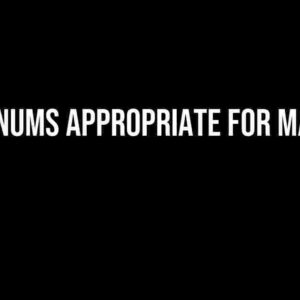Introduction
When working with collections in programming, it’s not uncommon to encounter situations where you need to transform a list into a set. Sounds simple, right? However, things can get messy quickly, especially when it comes to the order of elements. In this article, we’ll delve into the world of list to set transformations, exploring why this process seems to change the order of elements and what you can do to maintain the original order.
What is a List?
Before we dive into the transformation process, let’s quickly define what a list is. In programming, a list is a collection of items that can be of any data type, including strings, integers, and objects. Lists are denoted by square brackets `[]` and are often used to store a sequence of values.
my_list = [1, 2, 3, 4, 5] print(my_list) # Output: [1, 2, 3, 4, 5]
What is a Set?
A set, on the other hand, is an unordered collection of unique elements. Sets are denoted by curly braces `{}` and are commonly used to store a group of distinct values.
my_set = {1, 2, 3, 4, 5}
print(my_set) # Output: {1, 2, 3, 4, 5}
The Problem: List to Set Transformation
Now, let’s say you have a list and you want to convert it into a set. You might expect the resulting set to maintain the same order as the original list. However, that’s not always the case.
my_list = [1, 2, 3, 4, 5]
my_set = set(my_list)
print(my_set) # Output: {1, 5, 2, 3, 4} (or any other order)
As you can see, the resulting set is not in the same order as the original list. But why does this happen?
Why Does the Order Change?
The reason for this behavior lies in how sets are implemented. Sets in most programming languages, including Python, use a hash table to store elements. Hash tables use a hash function to map each element to a unique index, allowing for fast lookup and insertion operations. However, this process involves randomizing the element order.
When you convert a list to a set, the hash table implementation takes over, and the original order is lost. This is because sets are designed to be unordered collections, and the order of elements is not guaranteed.
Solutions to Maintain the Original Order
So, what can you do to maintain the original order of elements when transforming a list to a set? Here are a few solutions:
Ordered Set (python 3.7+)
In Python 3.7 and later, you can use the `OrderedDict` from the `collections` module to create an ordered set.
from collections import OrderedDict my_list = [1, 2, 3, 4, 5] my_set = OrderedDict.fromkeys(my_list) print(my_set) # Output: OrderedDict([(1, None), (2, None), (3, None), (4, None), (5, None)])
Sorted Set (python 3.x)
Alternatively, you can use the `sorted` function to sort the set based on the original list order.
my_list = [1, 2, 3, 4, 5] my_set = sorted(set(my_list), key=my_list.index) print(my_set) # Output: [1, 2, 3, 4, 5]
Convert to a List of Tuples (python 2.x)
In Python 2.x, you can convert the list to a list of tuples, where each tuple contains the index and value from the original list.
my_list = [1, 2, 3, 4, 5]
my_set = set([(i, x) for i, x in enumerate(my_list)])
print(my_set) # Output: {(0, 1), (1, 2), (2, 3), (3, 4), (4, 5)}
Conclusion
In conclusion, the list to set transformation seems to change the order of elements because of the hash table implementation used in sets. However, by using ordered sets, sorted sets, or converting to a list of tuples, you can maintain the original order of elements.
Remember, when working with collections, it’s essential to understand the underlying implementation and its implications on your code.
FAQs
-
Q: Why do sets use hash tables?
A: Hash tables provide fast lookup and insertion operations, making sets efficient for storing and retrieving unique elements.
-
Q: Can I use lists instead of sets?
A: Yes, but lists allow duplicate elements, whereas sets do not. If you need to maintain a collection of unique elements, sets are a better choice.
-
Q: Are there other ways to maintain the original order?
A: Yes, other programming languages and libraries may provide alternative solutions. However, the methods mentioned in this article are specific to Python.
Additional Resources
- Python Documentation: https://docs.python.org/3/tutorial/datastructures.html
- Hash Table Implementation: https://en.wikipedia.org/wiki/Hash_table
- OrderedDict Documentation: https://docs.python.org/3/library/collections.html#collections.OrderedDict
| Method | Python Version | Description |
|---|---|---|
| Ordered Set | 3.7+ | Uses OrderedDict to create an ordered set |
| Sorted Set | 3.x | Sorts the set based on the original list order |
| Convert to List of Tuples | 2.x | Converts the list to a list of tuples, maintaining the original order |
Frequently Asked Question
Get the inside scoop on converting lists to sets and what it means for your data’s order!
Why does converting a list to a set seem to change the order of elements?
This is because sets in Python are inherently unordered data structures. When you convert a list to a set, the order of elements is lost. Sets are designed to store unique elements, and they don’t preserve the original order. This means that the resulting set may appear to have a different order than the original list.
Is there a way to maintain the original order when converting a list to a set?
In Python 3.7 and later, you can use the built-in `dict` to maintain the insertion order. You can convert your list to a dict with a dummy key, and then get the keys as a list. This will preserve the original order. Alternatively, you can use an OrderedDict from the collections module, which also maintains the insertion order.
What if I need to preserve the order for a specific reason?
If you need to preserve the order for a specific reason, it’s generally better to stick with lists or use a data structure that maintains order, such as a list or a collections.OrderedDict. If you still need to use sets for their unique element property, consider using a combination of both data structures. For example, you can use a set to store unique elements and a list to maintain the original order.
How can I debug issues related to list to set conversion?
When debugging issues related to list to set conversion, make sure to check the type of data structure you’re working with. Verify that you’re not inadvertently converting your list to a set, and vice versa. Pay attention to any errors or warnings related to ordering, and consider using print statements or a debugger to visualize the data flow.
Are there any performance implications when converting a list to a set?
Converting a list to a set can have performance implications, especially for large datasets. Sets have a faster lookup time than lists, but the conversion process itself can be slower. Additionally, sets use more memory than lists because they store additional information for fast lookup. Consider the trade-offs and optimize your code accordingly.







